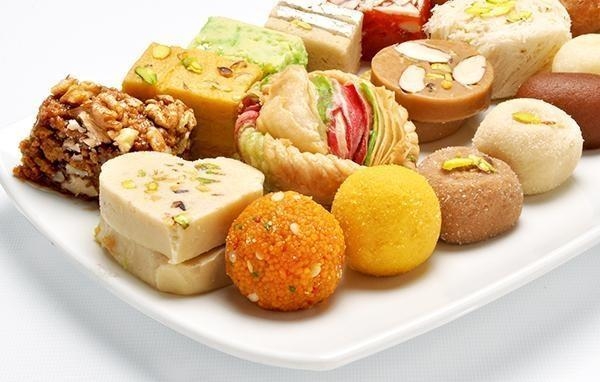ஸ்வீட் இல்லாத கொண்டாட்டங்கள் இனிப்பதில்லை. மற்றவர்களுடன் மகிழ்ச்சியைப் பகிர்ந்துகொள்ளவும், அன்பை வெளிப்படுத்தவுமான உணர்வுபூர்வமான நிகழ்வுகளில் தவிர்க்க இயலாத ஒன்று ஸ்வீட். யாரையாவது பார்க்கக் கிளம்புவோம், `ஒரு அரைகிலோ இனிப்பு வாங்கிட்டுப் போவோம்’ என ஸ்வீட் கடைப் பக்கம் ஒதுங்குவோம். லட்டு, ஜிலேபி, ரஸகுல்லா... என நமக்குப் பிடித்த இனிப்புகளை வாங்கிக்கொண்டு போவோம். உறவினர்கள், நண்பர்களைப் பார்க்கப் போவது மட்டுமல்ல, சாதாரணமாகவே ஏதோ ஒரு மகிழ்ச்சியான சம்பவத்தைக் கொண்டாடக்கூட உதவுவது இந்த இனிப்பு வகைகள்தான்.

சாலைகளில் செல்லும்போது, நம் கவனத்தை பல ஸ்வீட் ஸ்டால்கள் ஈர்ப்பதுண்டு. பல வண்ணங்களில், விதவிதமான டிசைன்களில், இனிப்புகளை ஒன்றன்மீது ஒன்றாக அழகாக அடுக்கிவைத்திருப்பார்கள். பார்க்கும்போதே, இதை வாங்கலாமா, அதை வாங்கலாமா, சமயத்தில், அத்தனையையும் வாங்கி விடலாமா என்றுகூடத் தோன்றும். அப்படி வாங்கும் `இனிப்புப் பலகாரங்களோடு ஆபத்தும் சேர்ந்தே வரலாம்’ என்கிறார்கள் மருத்துவர்கள்.

`தரமான எண்ணெய் அல்லது நெய், சர்க்கரை, மாவு, நிர்ணயிக்கப்பட்ட வண்ணம் ஆகியவற்றைப் பயன்படுத்தித்தான் ஸ்வீட் தயாரிக்க வேண்டும்’ என்கிறது உணவு தரக்கட்டுப்பாட்டு நிறுவனம். ஆனால், பெரும்பாலான பேக்கரி மற்றும் ஸ்வீட் ஸ்டால்களில் தரமற்ற எண்ணெய், தரமற்ற மூலப்பொருள்களைக் கொண்டு, வாடிக்கையாளர்களைக் கவர்ந்திழுக்க கண்ணைப் பறிக்கும் நிறங்களில் ஸ்வீட் தயாரித்து விற்பனை செய்கிறார்கள். இவற்றைச் சாப்பிடுபவர்கள் பல்வேறு உடல் உபாதைகளுக்கு ஆளாக நேரிடலாம்.
சோப்பு, ஷாம்பூ, எண்ணெய்... என நாம் பயன்படுத்தும் அத்தியாவசியப் பொருள்கள் அனைத்திலும் அவை கலாவதியாகும் நாள் குறிப்பிடப்பட்டிருக்கும். அதைப் பயன்படுத்தலாமா எனப் பார்த்து வாங்கலாம். ஆனால், ஸ்வீட் ஸ்டால்கள், பேக்கரிகளில் விற்பனையாகும் இனிப்புகள் என்றைக்குத் தயாரிக்கப்பட்டவை என்பது கடைகாரர்களுக்கே வெளிச்சம். அதேபோல, எத்தனை நாளைக்குள் அவற்றைப் பயன்படுத்தலாம் என்பதும் நம்மில் பலருக்குத் தெரிவதில்லை. சில நேரங்களில் வீட்டுக்கு வந்து, வாங்கிவந்த ஊசிப்போன வாடையடிக்கும் முறுக்கையோ, ஸ்வீட்டையோ சாப்பிட்டுவிட்டு முகம் சுளிப்போம். அதிகபட்சமாக அந்தக் கடையில் போய் திரும்ப பலகாரம் வாங்கக் கூடாது என முடிவெடுப்போம். அதே இனிப்பை நாம் யாருக்காவது கொடுத்திருந்தால், அவர் நம்மைப் பற்றி என்ன நினைப்பார் என்று எண்ணிப் பாருங்கள்! ஆக, இனிப்புகளுக்கும் காலாவதி உண்டு. அதை அறிந்துகொள்ள வேண்டியது அவசியம்.

சரி... இனிப்புகளுக்கான காலவதி தேதியை அறிவது எப்படி? மூத்த உணவியல் நிபுணர் தாரணி கிருஷ்ணனிடம் கேட்டோம்.
"எந்த உணவுப் பொருளுக்குமே காலவதியாகும் தேதி என்ற ஒன்று உண்டு. அந்த நாளுக்குள் அதைப் பயன்படுத்திவிடுவதுதான் நல்லது. மற்ற உணவுகளைப்போல ஸ்வீட்டுக்கும் இது பொருந்தும்.
எப்படிக் கண்டறிவது?
ஸ்வீட் வாங்கும்போது, முதலில் அதில் வெள்ளையாக பூஞ்சைத் தொற்று உள்ளதா என்பதைக் கவனிக்க வேண்டும். அது, ஸ்வீட்டைக் கையில் எடுத்துப் பார்த்தாலே தெரிந்துவிடும். அதேபோல ஓர் இனிப்புப் பலகாரம், நாம் வழக்கமாகப் பார்க்கும் நிறத்தைவிட அதிகளவு ஈர்க்கக்கூடிய நிறத்தில் இருக்கக் கூடாது. ஸ்வீட் கெட்டுப்போய்விட்டதா என்பதை அதன் சுவையே உணர்த்திவிடும். அப்படி கெட்டுப்போயிருக்கும் எனச் சந்தேகப்பட்டால், சிறிதளவு சாம்பிள் வாங்கிக் கடையிலேயே சாப்பிட்டுப் பார்த்துவிட்டு, பிறகு வாங்குவது நல்லது.

ஸ்வீட் ஈக்கள் மொய்த்தபடி சுகாதரமற்ற நிலையில் இருந்தால், வாங்கக் கூடாது. சூரிய ஒளி பலகாரங்களின் மேல் நேரடியாகப் படாதவாறு பராமரிக்கப்படுகிறதா என்பதையும் சரிபார்த்துவிட்டுப் பிறகு வாங்க வேண்டும்.
இனிப்பு பொருள்களில் பால், ஜீரா (சர்க்கரை நீர்) சேர்க்கப்படும் அளவைப் பொறுத்து அவை கெட்டுப்போகும். எண்ணெய்களால் தயாரிக்கப்பட்ட இனிப்புகளைவிட, நெய்யால் தயாரிக்கப்பட்டவை அதிக நாள் கெடாமல் இருக்கும்.
பொதுவாக, எந்த இனிப்பையும், அது தயாரிக்கப்பட்ட நான்கு நாள்களில் சாப்பிட்டுவிடுவது நல்லது. பாக்கெட்டில் அடைத்து விற்பனை செய்ப்படும் ஸ்வீட்ஸில் காலாவதி தேதியைச் சரிபார்த்துத்தான் வாங்க வேண்டும். மில்க் ஸ்வீட்கள் சாதாரணமாக இரண்டு நாள்கள் வரை கெட்டுபோகாமல் இருக்கும். கெட்டுப்போன இனிப்புகள் வயிற்றுப்போக்கை உண்டாக்கும். சில நேரங்களில் வயிற்றில் பாக்டீரியா உள்ளிட்ட தொற்று வரலாம்" என்கிறார் தாரணி கிருஷ்ணன்.

இதுதொடர்பாக அரசு என்ன செய்கிறது... கெட்டுப்போன பலகாரங்களை விற்கும் கடைக்காரர்கள் மேல் நடவடிக்கை எடுப்பார்களா? உணவு பாதுகாப்புத் துறை அலுவலகத்தைத் தொடர்புகொண்டு இதுபற்றி விசாரித்தோம். அங்கிருந்த அதிகாரி ஒருவர் நம்மிடம் பேசினார்... ``உணவு பாதுகாப்புத் துறை சார்பில் அமைக்கப்பட்ட குழுவினர் தங்கள் பகுதியில் உள்ள பேக்கரி மற்றும் ஸ்டால்களில் திடீர் ஆய்வு செய்வார்கள். ஒவ்வொரு குழுவிலும் நான்கு அதிகாரிகள் இருப்பார்கள். இவர்கள் அடிக்கடி ஆய்வுமேற்கொண்டு சந்தேகத்துக்குரிய ஸ்வீட்களில் சிறிதளவு எடுத்து ஆய்வுக்கு அனுப்புவார்கள். மற்றபடி, புகார் வந்தாலும் ஸ்வீட் ஸ்டாலுக்கு நேரில் சென்று ஆய்வுசெய்வார்கள். இந்த ஆய்வுகளின்போது, இனிப்பு வகைகளில் அனுமதிக்கப்பட்ட கலரைவிட கூடுதலாக கலர் சேர்க்கப்பட்டிருக்கிறதா, தண்ணீர், எண்ணெய், மைதா மாவு, சர்க்கரை உள்பட ஸ்வீட் தயாரிக்கப் பயன்படும் பொருள்கள் தரமானவையாக இருக்கின்றனவா போன்றவற்றையெல்லாம் ஆய்வின்போது கவனிப்பார்கள்.
இனிப்பு வகைகளில் ஏதாவது கலப்படம் கலக்கப்பட்டு இருப்பது தெரியவந்தால், அந்த உரிமையாளருக்கு நோட்டீஸ் அனுப்பப்படும். மேலும் தயாரிக்கப்பட்ட இனிப்புகள் சுகாதாரமற்றவையாக இருந்தால், பறிமுதல் செய்யப்படும். ஆய்வில் தரமற்ற பொருள்களை கொண்டு ஸ்வீட்ஸ் தயாரிக்கப்பட்டது தெரியவந்தால், சம்பந்தப்பட்ட ஸ்டால் உரிமையாளர் மீது உணவு பாதுகாப்புச் சட்டத்தின் கீழ் நடவடிக்கை எடுக்கப்படும். குறிப்பாக, தீபாவளி, பொங்கல் போன்ற பண்டிகை தினங்களில்தான் இதுபோன்ற தரமில்லாத பொருள்கள் அதிகளவு கைப்பற்றப்படுகின்றன.

மேலும், பொருளில் கலப்படம் இருப்பதாகச் சந்தேகம் வந்தால், அந்தப் பொருளோடு உங்கள் பகுதியின் சுகாதார அலுவலரைத் தொடர்புகொள்ளலாம். உணவு பாதுகாப்பு மற்றும் தர நிர்ணய ஆணைய அலுவலகத்தின் எண்களில் தொடர்பு கொண்டும் புகார் அளிக்கலாம்" என்றவர் தொடர்புகொள்ள வேண்டிய அந்த எண்களையும் நமக்குக் கொடுத்தார்.









